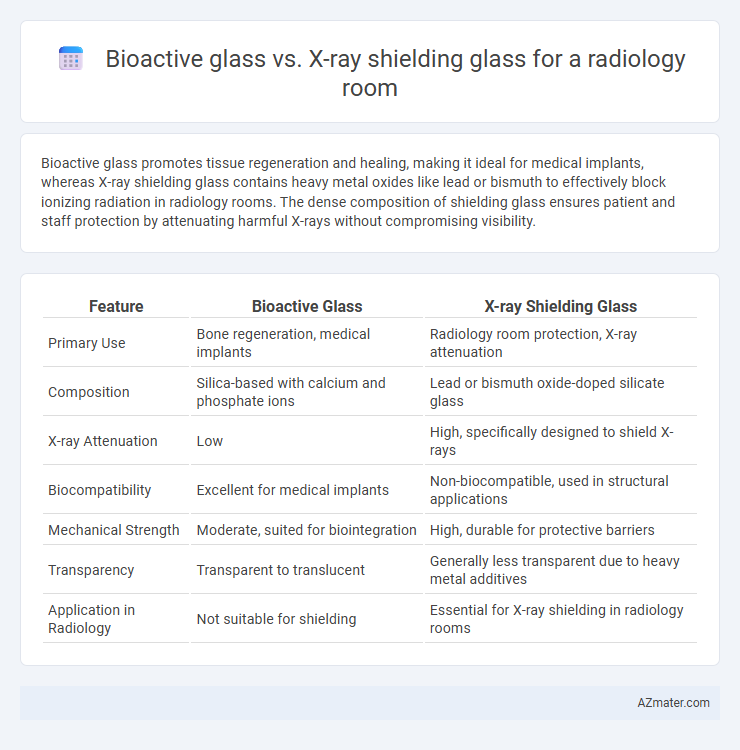Bioactive glass promotes tissue regeneration and healing, making it ideal for medical implants, whereas X-ray shielding glass contains heavy metal oxides like lead or bismuth to effectively block ionizing radiation in radiology rooms. The dense composition of shielding glass ensures patient and staff protection by attenuating harmful X-rays without compromising visibility.
Table of Comparison
| Feature | Bioactive Glass | X-ray Shielding Glass |
|---|---|---|
| Primary Use | Bone regeneration, medical implants | Radiology room protection, X-ray attenuation |
| Composition | Silica-based with calcium and phosphate ions | Lead or bismuth oxide-doped silicate glass |
| X-ray Attenuation | Low | High, specifically designed to shield X-rays |
| Biocompatibility | Excellent for medical implants | Non-biocompatible, used in structural applications |
| Mechanical Strength | Moderate, suited for biointegration | High, durable for protective barriers |
| Transparency | Transparent to translucent | Generally less transparent due to heavy metal additives |
| Application in Radiology | Not suitable for shielding | Essential for X-ray shielding in radiology rooms |
Introduction to Glass Materials in Radiology Rooms
Glass materials in radiology rooms must combine high durability with effective radiation shielding to ensure safety and functionality. Bioactive glass offers biocompatibility and promotes healing, making it ideal for medical implants but less effective for blocking X-rays. X-ray shielding glass, typically containing heavy metal oxides like lead or barium, provides superior attenuation of ionizing radiation, essential for protecting personnel and patients in diagnostic environments.
Overview of Bioactive Glass: Composition and Properties
Bioactive glass is primarily composed of silica (SiO2), calcium oxide (CaO), sodium oxide (Na2O), and phosphorus pentoxide (P2O5), designed to bond with biological tissues and promote bone regeneration. Its unique properties include high biocompatibility, osteoconductivity, and the ability to release beneficial ions that stimulate cellular activity. Unlike traditional X-ray shielding glass, bioactive glass does not provide radiation protection but excels in medical applications requiring tissue integration and healing.
Fundamentals of X-ray Shielding Glass
X-ray shielding glass is engineered with high-density materials like lead oxide or bismuth oxide to effectively attenuate ionizing radiation, ensuring safety in radiology rooms by absorbing and reducing X-ray penetration. Bioactive glass, primarily used for medical implants, lacks the high atomic number elements necessary for sufficient X-ray attenuation, making it unsuitable for radiation shielding purposes. The fundamental principle of X-ray shielding glass relies on its composition and thickness to provide optimal radiation protection while maintaining transparency for visibility in medical imaging environments.
Mechanism of Radiation Protection: Bioactive vs X-ray Shielding Glass
Bioactive glass provides radiation protection primarily through its dense chemical composition that absorbs scattered X-rays, while also promoting biocompatibility for safer clinical environments. X-ray shielding glass contains heavy metal oxides such as lead oxide, which effectively attenuate X-ray photons by increasing the glass density and atomic number, thereby enhancing shielding efficiency. The distinct mechanisms involve bioactive glass integrating with biological tissues to reduce indirect radiation effects, whereas X-ray shielding glass focuses on direct photon absorption and scattering prevention.
Structural and Mechanical Differences Between Glass Types
Bioactive glass exhibits a highly porous structure with enhanced bioactivity, promoting tissue integration, whereas X-ray shielding glass features a dense, heavy-metal embedded matrix designed for maximum radiation attenuation. Mechanically, bioactive glass tends to have lower compressive strength but superior bio-compatibility, while X-ray shielding glass demonstrates higher hardness and fracture toughness necessary to withstand operational stresses in radiology environments. The distinct composition and microstructural differences directly influence their performance in radiology rooms, balancing between biological interaction and protective function.
Clinical Safety and Biocompatibility Considerations
Bioactive glass offers superior biocompatibility by promoting cell adhesion and tissue regeneration, reducing the risk of inflammatory responses in radiology rooms. In contrast, X-ray shielding glass prioritizes radiation attenuation through heavy metal incorporation, which may pose toxicity concerns if not properly encapsulated. Clinical safety demands a balance between effective radiation protection and material biocompatibility, making bioactive glass a promising option for applications requiring both properties.
Cost Comparison and Long-term Sustainability
Bioactive glass typically incurs higher initial costs due to advanced materials and manufacturing processes, whereas X-ray shielding glass tends to be more cost-effective upfront, especially for large installations. Long-term sustainability favors bioactive glass because of its superior biocompatibility, durability, and potential for reduced environmental impact through recyclability and lower maintenance requirements. X-ray shielding glass may require more frequent replacement or upgrades, increasing total cost of ownership over time despite lower initial expenditures.
Installation and Maintenance in Radiology Settings
Bioactive glass offers easy installation in radiology rooms due to its lightweight and moldable properties, reducing structural modifications and downtime. Maintenance of bioactive glass is minimal as its surface resists biofilm formation and provides long-term durability against chemical and mechanical wear. In contrast, X-ray shielding glass requires precise alignment and heavier structural support during installation, with maintenance focusing on preserving lead or barium layers to prevent shielding degradation over time.
Environmental Impact and Recyclability
Bioactive glass is environmentally favorable due to its non-toxic composition and potential for biointegration, promoting sustainability in medical waste management. In contrast, X-ray shielding glass contains heavy metals like lead or barium, raising concerns about toxicity and difficult recyclability. Sustainable radiology room design increasingly prefers bioactive glass to reduce hazardous waste and facilitate eco-friendly recycling processes.
Future Trends in Radiology Room Glass Technology
Bioactive glass in radiology rooms is emerging for its biocompatibility and ability to promote healing, while X-ray shielding glass remains essential for radiation protection with lead or barium composites enhancing attenuation efficiency. Future trends focus on developing multifunctional glass combining high radiation shielding performance with antimicrobial and self-healing properties to improve safety and durability. Advances in nanotechnology and glass composite materials will enable thinner, lighter, and environmentally friendly shielding solutions tailored for next-generation radiology environments.

Infographic: Bioactive glass vs X-ray shielding glass for Radiology room
 azmater.com
azmater.com